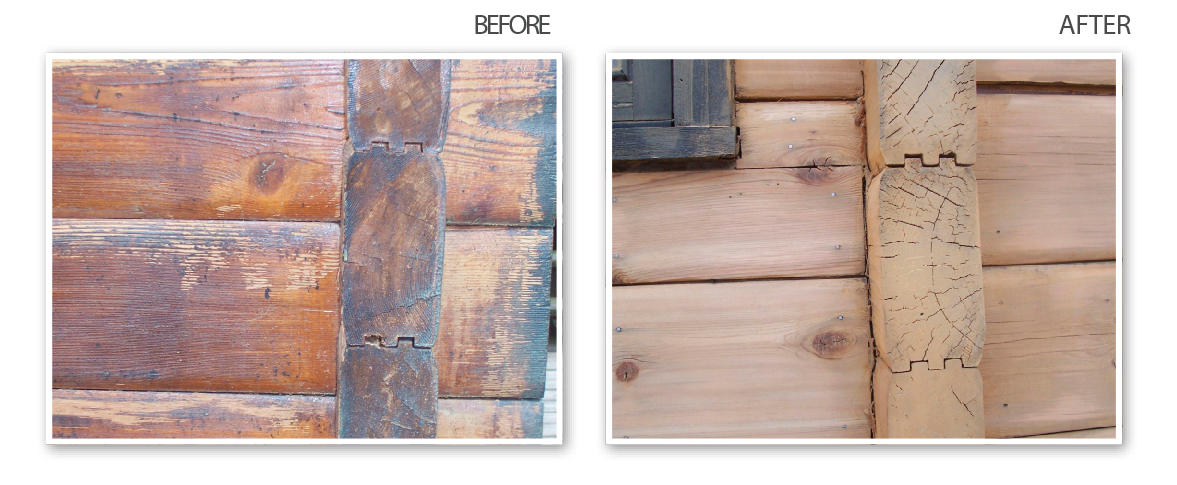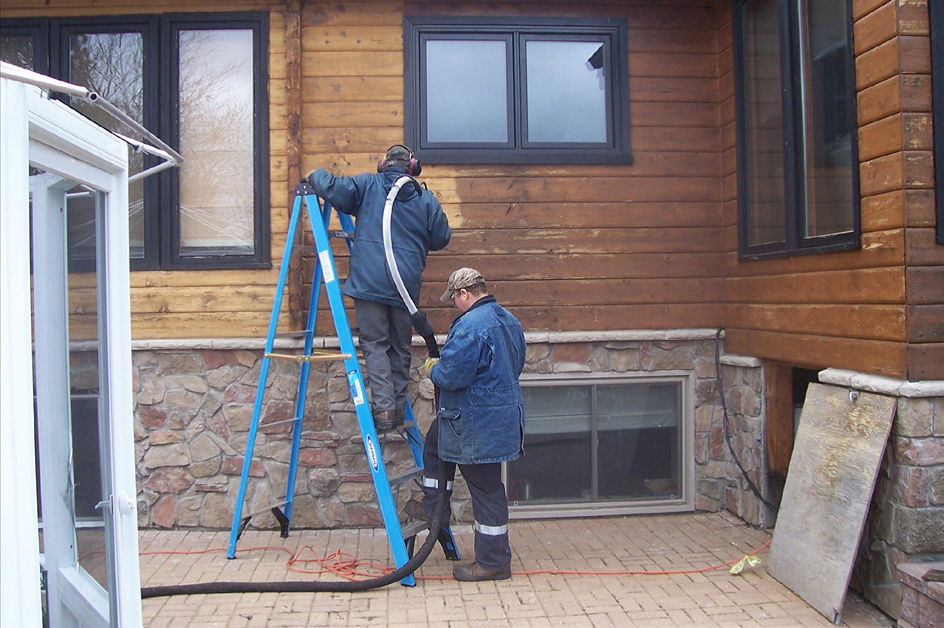In order to properly restore a log home, the exterior must be thoroughly cleaned, sanded and then stained. If the surface is not cleaned thoroughly to remove all contaminants, the new layer of stain and sealant will not adhere correctly and will not last long-term.
Oftentimes, there are multiple layers of stain that need to be cleaned and removed before a new layer can be added and the log home’s exterior fully restored.
A home owner in Bonfield, Ontario, wished to restore his 15-year-old cedar log home and bring it back to its original beauty. Over the years, the exterior stain had begun to peel and become layered with dirt and mold. The exterior had been re-stained multiple times but never cleaned in between, causing a 15 year buildup of stain, dirt and mold. In order to put on a fresh, new coat of stain, all of the old layers must first be removed. The team at Bonazza Dry Ice Blasting was contacted to do the job.
Traditional methods weren't viable
Traditional methods of surface preparation were considered, including pressure washing, but the water would get into the wood and cause the stain to peel sooner.
Blasting with corn cob, sand, soda, walnuts and glass would be too abrasive and cause a large mess. Chemical stripping was an alternative but would introduce safety and environmental considerations, as well as add additional time to the project as the wood would need to dry after the chemical treatment. Hand sanding as an option would be extremely time and labor intensive. In order to properly re-stain and restore the home, a less aggressive and more efficient cleaning method was needed.
Learn about dry ice blasting for restoration projects
Dry ice blasting chosen to restore the home
Cleaning with dry ice blasting was the perfect solution because it uses non-abrasive media in the form of recycled CO2 pellets that will not damage surfaces. The dry ice media is introduced into a pressurized air stream at user-controlled speeds and sublimates – or turns back into a gas – upon impact, lifting away the contaminant safely, without leaving behind any secondary waste or residue.

“Dry ice cleaning can take years off the look of a log home,” said Vinni Bonazza, Owner of Bonazza Dry Ice Blasting. “It takes a thin layer of wood off all the logs – about 1/16 of an inch – leaving all of the milling marks. This is a great way to rejuvenate the interior and exterior of a log home.”
Dry ice cleaning is odorless, does not add moisture back to the wood and can be done cleanly, with no hazardous solutions dripping on workers. It can be used on all types of wood, including pine, fir and cedar. Even though cedar shakes are soft and thin, dry ice is soft enough not to penetrate too deeply or damage the wood. Dry ice also works well on cleaning teak, one of the hardest types of wood to clean or strip.
Learn more about how dry ice blasting works
Dry ice blasting delivered results
The team at Bonazza Dry Ice Cleaning used a dry ice blasting machine to clean a total of 1,600 square feet on the exterior of the cabin. The nozzle used allowed them to clean at a steady pace because the dry ice particles were moving at a continuous flow. Once fully cleaned, the surface was lightly sanded and then two fresh coats of stain were applied to complete the restoration process.
The entire log home restoration project time included:
- 24 hours of cleaning and surface preparation with dry ice
- 1,500 lbs. of dry ice pellets
- 52 hours of sanding
- 33 hours of staining
“The project was on schedule and incredibly fast,” said Bonazza. “We saved at least three to four days when compared to sand or corn blasting and two days of sanding time. The log home looks brand new – it came out 110%.”
.png) English
English
